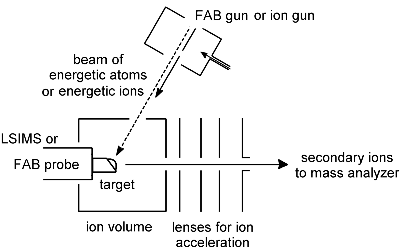a) Particle impact-induced desorption/ionization methods are numerous in mass spectrometry. Do you know them all?
- FAB: fast atom bombardment (organic applications)
- SIMS: secondary ion mass spectrometry (organic and inorganic surface analysis)
- PD: plasma desorption (alpha-particles from 252Cf, biomedical applications)
- LSIMS: liquid secondary ion mass spectrometry (organic applications)
- MBSA: molecular beam solid analysis (precursor of FAB)
- MCI: massive cluster impact (glycerol cluster ions, biomedical applications)
b) What kind of particles are impacting onto the surface in case of FAB and what kind in LSIMS?
In FAB, the surface is bombarded chiefly by neutral atoms of argon or preferably xenon; LSIMS uses Cs+ ions instead.
c) Why isn’t PD suitable for magnetic sector analyzers? What type of analyzer is employed instead?
Plasma desorption uses alpha-particles typically generated by radioctive decay of 252Cf which is a spontaneous process. Thus, 252Cf-PD doesn’t provide a continuous ion beam as required for sector instruments but is ideally suited for time-of-flight (TOF) mass analyzers.
d) Can you draw the basic setup of a FAB or LSIMS ion source?
